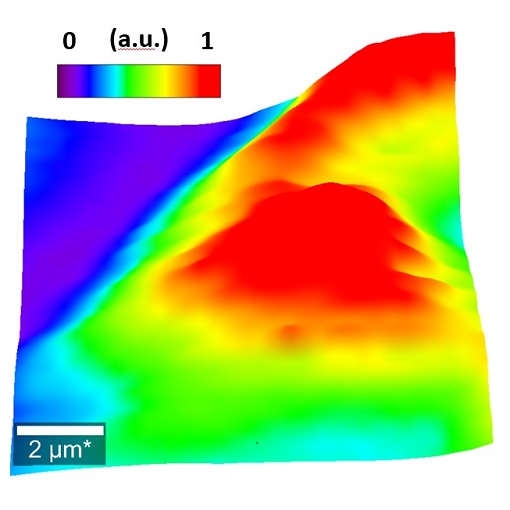
Super-emissive van der Waals heterostructures
Various technologically useful optoelectronic features emerge in van der Waals heterostructures (vdWh) wherein a few-layer hexagonal boron nitride (hBN) is sandwiched between monolayers of a transition-metal dichalcogenide (TMD). The groups of Martin Kalbac (Czech Academy of Sciences, Czech Republic) and Jana Vejpravova (Charles University, Czech Republic) have for the first time observed entangled superradiant excitons in such vdWh. By measuring photoluminescence with attoRAMAN microscope, they demonstrated strong suppression of phonon population at temperatures < 15 K. Excitons then self-assemble into an ordered array in a head-to-tail manner in vdWh, and in turn collectively oscillate and coherently radiate even at extremely low pumping intensity. Super-emissive vdWh are also an excellent playground for studying many-body correlations.
This measurement was realized with the attoRAMAN.
Further reading:
G. Haider et al., Adv. Funct. Mater. 2021, 2102196 (2021)
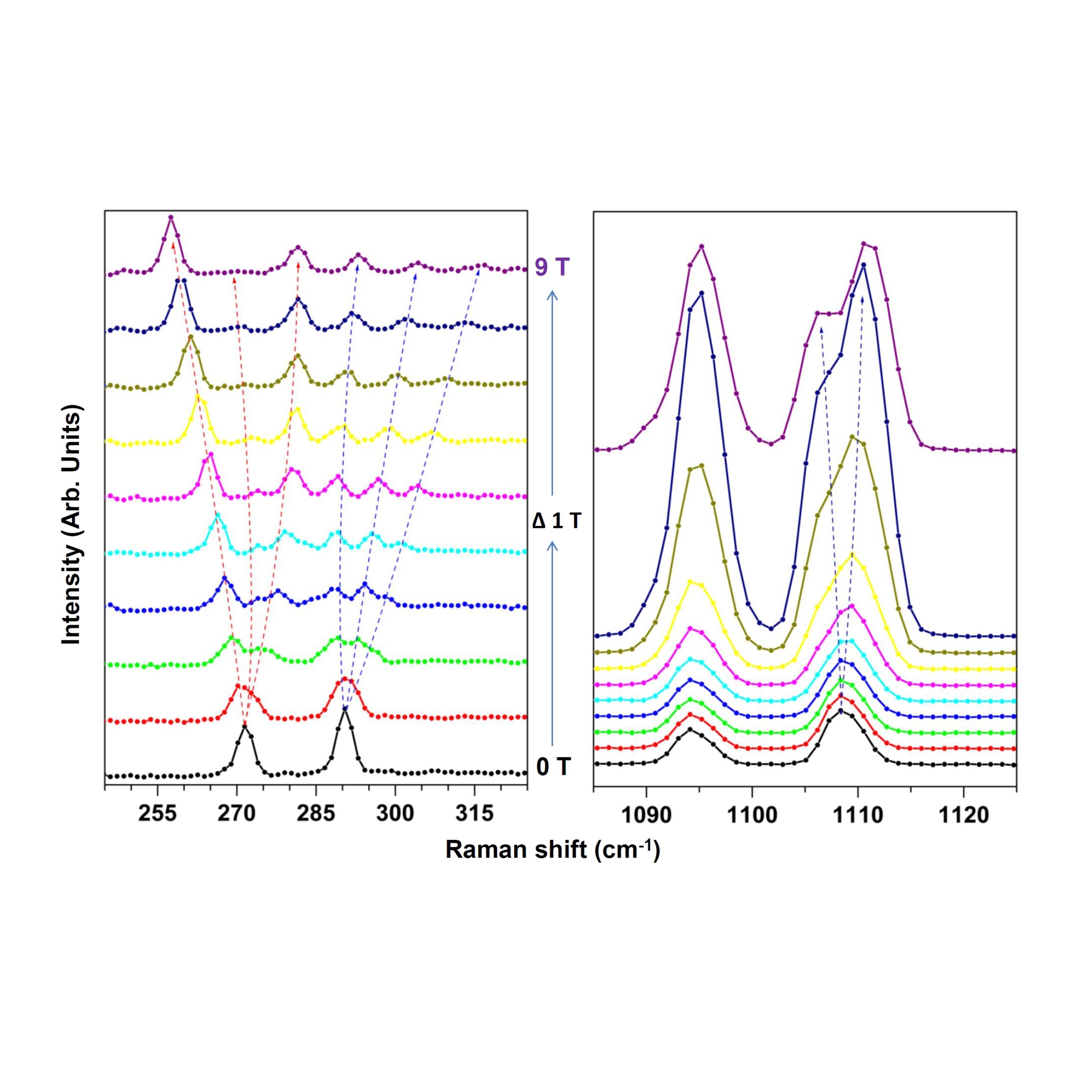
Magnetic Modes in Rare Earth Perovskites: A Magnetic-Field-Dependent Inelastic Light Scattering study
Intrinsically inert rare earth perovskites, like LaAlO3, can be turned into optically and magnetically active materials by introducing certain cations or vacancies. The groups of Thirumalai Venkatesan (National University of Singapore, Singapore), Surajit Saha (Indian Institute of Science Education and Research, India), and Ting Yu (Nanyang Technological University, Singapore) performed a cryogenic magneto-Raman study on several rare-earth perovskites free of magnetic impurities. The measurements revealed the presence of defect-states with magnetic degrees of freedom in the bandgap. Their results, which have been obtained with attoRAMAN microscope and attoLIQUID2000 cryostat, exhibit how appropriate defect engineering can induce orbital magnetization that can render rare earth perovskites useful for novel magnetic and magneto-optic applications.
This measurement was realized with the attoRAMAN.
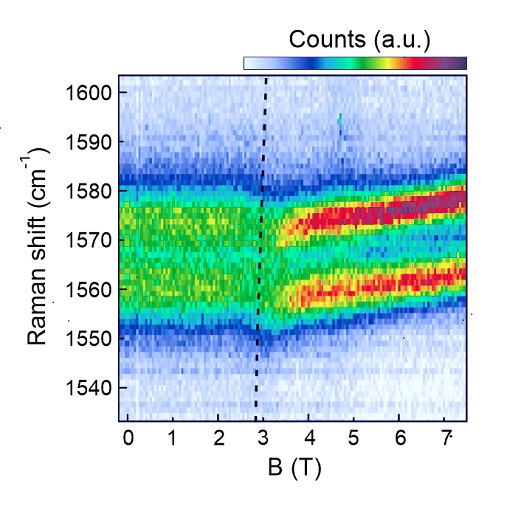
Manipulating phonons
Phonons govern various thermal, optical and electronic properties of materials. Potential phononic applications require the possibility of manipulating phonon modes. Yet, due to their spinlessness and large nuclear inertia, phonons are difficult to manipulate by electromagnetic fields. Exception thereto are systems with strong electron-phonon interaction, where manipulation of phonons is achieved indirectly by manipulating the electrons. Graphene makes a perfect system for studying the manipulation of phonons, as it possesses unique electron-phonon coupling mechanisms and the ability for excellent external control over its electrons. Utilizing an attoRAMAN microscope in an attoLIQUID2000 cryostat, the group of Christoph Stampfer (RWTH Aachen University, Germany & Forschungszentrum Jülich, Germany) explored the tunability of the phonon polarization in suspended uniaxially strained graphene by magneto-phonon resonances. By electrostatic doping they can selectively couple the phonons to right- or left-handed polarized Landau level transitions, which in turn also fixes the circular polarization of the phonon modes. They have achieved an unprecedented electrostatic control over the angular momentum of phonons: circular phonon polarization of up to 40% has been reached exclusively by electrostatic fields, and the polarization handedness can be reversed by changing the dopants from electrons to holes. Such remarkable findings pave the way towards phononic applications.
This measurement was realized with the attoRAMAN.
Further reading:
J. Sonntag et al., Nano Lett. 21, 2898 (2021)
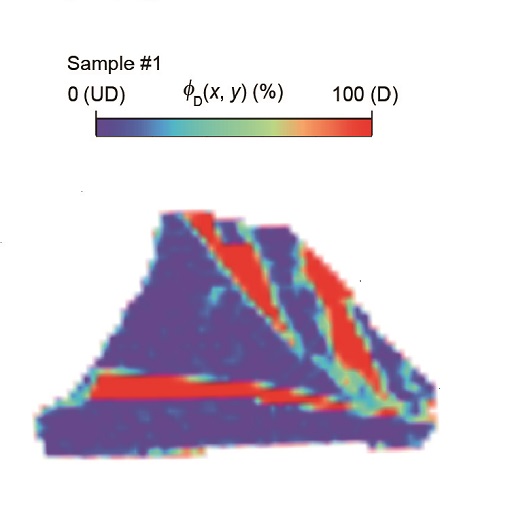
Macroscopic manifestation of microscopic complexity
For many-body systems in thermodynamic limit, phase evolution that occurs at the microscopic level - and that is highly complex - does not influence the macroscopic phase evolution, hence no significant uncertainties can be associated with measurements of macroscopic physical quantities. Yet, for small enough systems that are below thermodynamic limit, complex behavior at the microscopic level may manifest itself macroscopically as emergent behavior. The group of Fumitaka Kagawa and Yoshinori Tokura (University of Tokyo, Japan & RIKEN Center for Emergent Matter Science, Japan) studied complexity of the phase evolution of transition-metal dichalcogenide IrTe2 flakes, via real-space imaging by cryogenic scanning Raman microscopy. In their experiments they used an attoRAMAN microscope. Their findings highlight emergent superconductivity, and exemplify the difference of phase evolution in bulk and flakes samples of IrTe2. This class of studies is also relevant for applications, as sample fabrication techniques of nowadays allow for the phase control of materials in solid-state nanodevices.
This measurement was realized with the attoRAMAN.
Further reading:
H. Oike et al., Phys. Rev. Lett. 127, 145701 (2021)
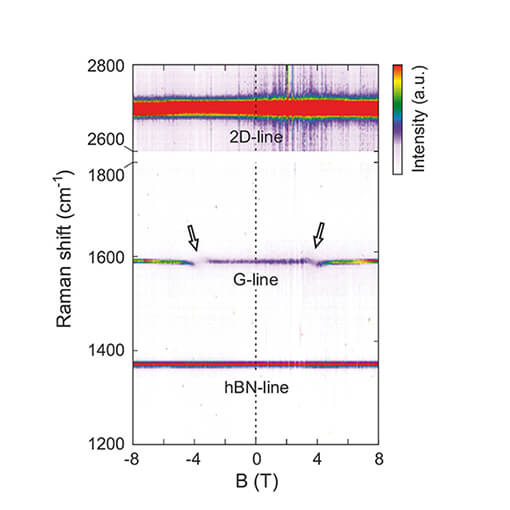
Magneto-Raman Microscopy for Probing Local Material Properties of Graphene
The combination of confocal Raman microscopy and magnetic fields at 4 K yields the opportunity to investigate and tune the electron-phonon interaction in graphene and few-layer graphene. In particular, excitations between Landau levels can resonantly couple to the Raman active long wavelength optical phonon (G-phonon), when their energies are matched, resulting in magneto-phonon resonances (MPRs). Such resonances at ±3.7 T are presented in the figure and highlighted by arrows. The details of the coupling depend on various material properties of the investigated graphene layer. From the MPRs, device parameters such as the electron-phonon coupling constant or the Fermi velocity of the charge carriers can be extracted. Interestingly for low charge carrier doping, the Fermi velocity shows signatures of many-body interaction effects.
This measurement was realized with the attoRAMAN.
Further reading:
C Neumann, et al., Nature Communications volume 6, 8429 (2015)
Addressing Strain and Doping by Cryogenic Raman Mapping
T. Verhagen in the Czech Academy of Sciences in Prague conducted a comprehensive study on the effects of temperature induced strain on two-layer Graphene sheets using an attoRAMANxs confocal Raman microscope. Using isotopical labelling, they can differentiate the influences of the surface on the lower and on the upper layer. A correlation analysis allows to separate strain and doping contributions to the observed Raman shifts. This detailed analysis allows to estimate temperature induced strain and doping contributions that are important when analyzing transport measurements on graphene mono- and bilayers.
Further reading:
T. G. A. Verhagen, et al., Phys. Rev. B 92 125437 (2015)



